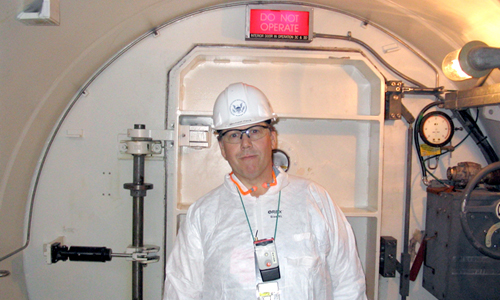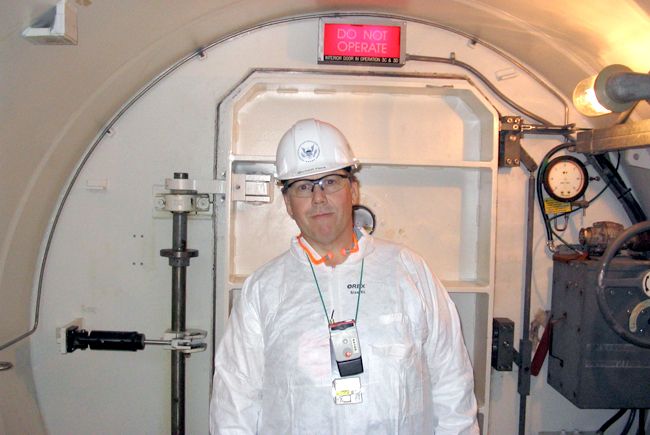
Doomsday Clock Moves Closer to Midnight As California’s Last Active Nuke Plant Puts Millions at Risk

Humanity’s clock is ticking but few in power seem to recognize how late it’s getting. The Bulletin of the Atomic Scientists has been keeping time though with their “Doomsday Clock,” established in 1947 to convey threats to humanity and the planet in the new atomic age launched by the Manhattan Project two years before. Widely recognized as an indicator of the world’s vulnerability to catastrophe from nuclear weapons, global climate change and other emerging technologies, the Doomsday Clock was moved forward two minutes in January to 11:57 p.m. It’s the closest the clock has been to midnight since the height of the Cold War in 1984.
“The clock ticks now at just three minutes to midnight because international leaders are failing to perform their most important duty—ensuring and preserving the health and vitality of human civilization,” the Bulletin’s Science and Security Board stated in their announcement. “The probability of global catastrophe is very high, and the actions needed to reduce the risks of disaster must be taken very soon.”
Global climate change and the nuclear weapons industry were listed as the primary threats, but the Bulletin’s analysis also cited “the leadership failure on nuclear power.” The Bulletin noted that “the international community has not developed coordinated plans to meet the challenges that nuclear power faces in terms of cost, safety, radioactive waste management, and proliferation risk.” The triple meltdown at Japan’s Fukushima Dai-ichi power plant in 2011 brought the issue to global attention after an unpredictable earthquake stronger than the plant was built to withstand overwhelmed the reactors in conjunction with a massive tsunami. This unprecedented disaster even led the U.S. Nuclear Regulatory Commission (NRC) to establish a Fukushima Lessons Learned Division. But the situation at California’s last remaining active nuclear plant has generated widespread concern about whether the NRC has learned anything at all from Fukushima.
Diablo Canyon—An American nuclear plant with troubling similarities to Fukushima
The Diablo Canyon Power Plant near scenic San Luis Obispo on the Golden State’s central coast sits in an area where several new fault lines have been discovered over the decades. Controversy flared in 2014 due to revelations about regulatory safety questions from the plant’s former senior resident inspector Michael Peck, who served in that role from 2007-12. Peck became concerned that new seismic data suggested the plant was operating outside the safety margins of its license. He issued a non-concurrence in 2012, a Dissenting Professional Opinion in 2013 and a DPO Appeal in 2014. Debate between Peck and his bosses at the NRC has centered around what methodology should be used to determine whether the plant could survive a massive quake it might not be built to withstand.
“I wrote the non-concurrence, DPO, and the Appeal to draw attention to the failure of the NRC to enforce nuclear safety rules and license requirements at the Diablo Canyon Power Plant. These requirements include the regulatory safeguards relied on to protect California residents from a radiation release following a major earthquake,” Peck said in a recent interview by both phone and email.
He went on to explain how NRC regulations require a plant’s operating license to be amended before “non-conservative” changes are applied to safety analysis methodologies, yet PG&E had been allowed to make such changes without a license amendment.
“PG&E completed a reevaluation of Diablo Canyon seismology in January 2011. This reevaluation concluded that three local faults were capable of exceeding equipment seismic qualification limits established by the facility design basis. In September 2014, PG&E completed an additional reevaluation as mandated by California Assembly Bill 1632. This latest reevaluation revealed that several of these faults are even more capable than previously considered,” Peck explained. “PG&E created the appearance that the facility design basis remained satisfied by presenting the reevaluation results using less conservative methods than specified in the facility license. While these new methods and assumptions may or may not be technically justifiable, NRC rules required that PG&E first obtain an amendment to the Operating License before they were used in facility safety analyses. When applying the licensed methodology, the new seismic data results in stress levels on important equipment well in excess of safety limits. As a result, key safety barriers protecting the public from a radiation release may fail following a major earthquake.”
Peck went against the politically desired outcome because PG&E was no longer adhering to the parameters of the plant’s license and the NRC was no longer enforcing it.
“Bypassing this regulatory framework was not only irresponsible but also represented a serious violation of the public trust. The amendment process also would have provided public notice and hearing opportunities for these facility safety analysis changes that directly affect the principle safety barriers for ensuring public protection from radiation,” Peck added.
The NRC put together a three-person “independent” panel to rule on Peck’s DPO. Eric Leeds, director of the NRC’s Office of Nuclear Reactor Regulation, appointed Mike Case, director from the Division of Engineering in the NRC’s Office of Nuclear Regulatory Research, as panel chair. Peck, as DPO submitter, was entitled to recommend one panel member and selected NRC’s Rudolph Bernhard, a senior reactor analyst. The other panel member selected by Leeds, Brit Hill, is a bit more curious. Hill is COO of NUTECH Energy Alliance, a Houston-based oilfield services company. He previously spent 13 years working for the notorious Halliburton Company, before moving on to NUTECH (which was co-founded by former Halliburton execs). NRC spokesperson Lara Uselding says Hill has relevant seismic experience and has worked with NRC for almost a decade.
The panel apparently spent almost a year analyzing Peck’s DPO before rejecting it in May of 2014 and declaring that PG&E had satisfied all regulatory requirements. A primary issue for Peck was a difference of opinion about Diablo Canyon’s Safe Shutdown Earthquake (SSE), the level of seismic activity the plant could withstand. Peck says the panel used “circular logic” in justifying a change to the seismic standard that conflicted with the facility’s license application (FSAR) and then used that assumption to support their conclusion.
“When I asked the Panel Chairman (Mike Case) the basis for their assumption, he directed me to a recently changed FSAR Section (Revision 21). NRC regulations (10 CFR 50.59) required PG&E to first obtain an amendment to the Operating License before changing either the facility design basis or using a less conservative methodology or input assumptions in safety analyses that demonstrate that the design basis is satisfied. So, the basis the Panel chairman provided was built on an unauthorized change of the Operating License by PG&E,” Peck says.

 233k
233k  41k
41k  Subscribe
Subscribe 


